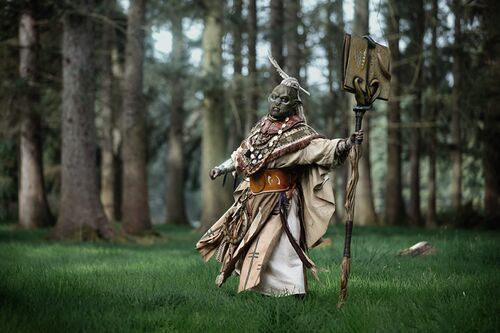Gralka's Gift to the Lost Seeker
Rules
Day Magnitude 4
Performing the Ritual
Performing this ritual takes at least 2 minutes of roleplaying. The ritual targets the nearby area.
This ritual requires a piece of glass or crystal as a focus that is studied during the performance.
It cannot be cast in a realm chamber, in the Hall of Worlds, during a past-life vision, or in similar circumstances.
Effects
This divination ritual will tell the caster(s) where they are. This will be as specific as possible, but might occasionally be as vague as the region they are in.
It is not possible to cast this ritual in a realm chamber, in the Hall of Worlds, or during a past-life vision.
On rare occasions, an area may be under the effect of a magical shroud or obscuring magic. If the shroud has a higher strength than the magnitude of the ritual, it reveals only whether there is information to be discerned, and the presence, realm, and magnitude of the shrouding effect.
Additional magnitude
You can increase the magnitude to overcome stronger shrouds.

Description
This ritual was codified for the Autumn Equinox 385YE at the Icy Crag of the Eternal Sun, under the guidance of the Master of Ice and Darkness, Ceinwen Eternal of Navarr. It was based on work performed by Skywise Gralka of the Imperial Orcs.
This simple divination ritual is similar to Clear Lens of the Eternal River, but the information it provides is much more fundamental. Rather than unveiling historical information about the locale, it provides the caster (or casters) with reasonably precise information about their physical location at the time the magic is performed. For example, performed anywhere at Anvil it will generally provide the information that one is in the town of Anvil, the region of Mareholm, in the territory of Casinea.
Generally it provides at least the name of a territory and the region within it. It may provide more, especially if there is a nearby landmark. In the absence of a landmark, it may provide the name of an area such as a forest, or area of hills.
There are several challenges presented by the divination. Some locations have more than one name, especially if they lie on a border between two lands. The pass between the Skogei Glens in Skarsind and Miechernya in Varushka is called Wulfric's Fall by the Winterfolk, but Ustyma's Gate by the Varushkans. In this case the divination will usually provide only one of those names. A few cautious experiments have demonstrated that the magic seems to prioritize names that might in theory have been familiar to the caster even if they have never heard them before. Experimentation shows that it provides the names Imperial citizens have given to places rather than older names given to them by original inhabitants, for example.
It can also be a challenge when the ritual is performed in an area that has no common name – not every geographical feature has been named. In this case, the ritual will provide as much information as it can.
Common Elements
As with several similar rituals, Gralka's Guidance to the Lost Seeker requires a focus in the form of a piece of glass or crystal that is studied during the casting. Lenses, discs of crystal or glass, polished pieces of tempest jade, and the like are all appropriate foci. There have also been a few successes using open flames through which the caster peers, or the still clear waters of pond or bowl.
Painting designs around the eyes, or on the brow, of the caster, are another way to focus the magic, as is the rune Sular, which represents discovery. A dramaturge might use a scene in which the Doctor lectures another character on geography, with the culmination of the play and the ritual being an explanation via dialogue of the exact location the action is taking place.
It might also be appropriate to invoke the symbolism of keen-eyed creatures such as hawks and eagles, wise heraldic creatures such as sphinx, the imagery of spiders, geese, and squirrels, or the names of paragons and exemplars of Wisdom, especially Kala who helped develop systems of measurement and had an innate connection to natural philosophy.